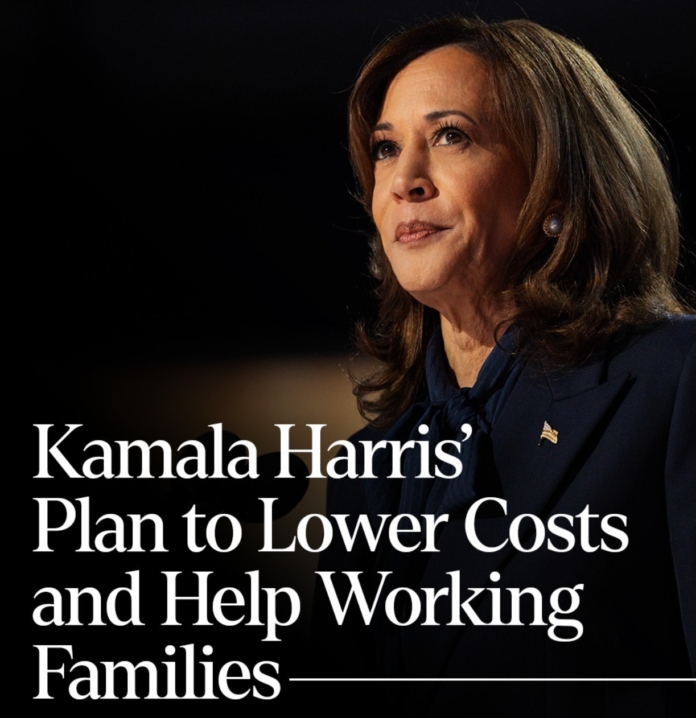Your trusted source for contextualizing the news. Sign up for our daily newsletter.
In announcing a groundbreaking new policy proposal — to expand Medicare to cover the cost of long-term care at home — Vice President Kamala Harris chose an audience made up of people most likely to be impacted: the women and older adults who watch the popular morning talk show “The View.”
Harris’ proposal would have enormous impact on middle-class Americans — a focus of her campaign. Unlike Medicaid, Medicare is not based on income and is available to all Americans over 65, as well as some younger people with specific medical conditions. Women in particular are poised to benefit from the proposed change as they are more likely to be caregivers for family members who need long-term care and to require care themselves as they age due to living longer on average than men. In addition, many families are currently part of what’s called the “sandwich generation,” meaning they are caring for both aging relatives and children at the same time.
“I took care of my mother when she was sick and she was diagnosed with cancer. And so it is a personal experience for me as well as something I care deeply about,” Harris told cohost Sunny Hostin on Tuesday morning. “It’s just about helping an aging parent or person prepare a meal, you know, put their sweater on. And it’s about dignity for that individual. It’s about independence for that individual.”
Polling from AARP shows that over half of Americans believe that Medicare already covers long-term nursing home care or a home health aide. It does not, and many Americans are shocked to learn that when they need that kind of help for themselves or family members, it is not available except under specific and punishing circumstances.
Currently, long-term care for people with disabilities and older adults is mostly paid for by Medicaid, a poverty program that requires recipients to have no more than $2,000 in their bank account at any given time, among other restrictions. Middle-class older adults who need intensive long-term care and who cannot pay hundreds of thousands out of pocket engage in what experts call a “Medicaid spend down.” Essentially, older adults have to sell off their possessions, empty their bank accounts and impoverish themselves in order to qualify for life-sustaining assistance with tasks like eating, using the bathroom and getting out of bed in the morning.
“This is the reality for most people in the current system because Medicaid is really the main game in town: It requires aging adults, disabled people, anyone who needs long-term supports and services to give up their retirement security, to give up money that they might have been saving to leave to their family in order to receive the care that they need,” said Nicole Jorwic, chief of advocacy and campaigns for the national organization Caring Across Generations and a longtime advocate for improvements in long-term care.
Harris’ proposal to expand Medicare coverage to long-term care is ambitious and would require an act of Congress. This may be a tall order. President Joe Biden’s own attempt to expand long-term care through Medicaid failed in 2022. Deficit hawks like West Virginia Sen. Joe Manchin, a registered Independent, balked at the expense.
Harris proposes paying for the change with savings from Medicare price negotiation, arguing that by paying less for prescription medication, beneficiaries will have more money left for other services. Currently, only 10 drugs are having their prices negotiated through an agreement with the Biden administration, but Harris aims to continue to expand the effort.
“It is a way to help people actually not just get by, but get ahead,” she said on “The View.”
The ability to pay for home care could also lessen the financial burden on families, she said. “For the family to send [someone] to a residential care facility or to hire somebody is so expensive.”
Depending on the state, sufficiently intensive care for older adults may only be available in a nursing home. According to a 2021 poll conducted by the nonpartisan AP-NORC Center at the University of Chicago, 88 percent of Americans would prefer to age in their own homes. The desire to age at home, rather than a nursing home, is consistently high in previous polling.
This was certainly the case for Lisa Traxler, 52, and her father, William Traxler, 80. William Traxler developed vascular dementia in 2021 and was no longer able to care for himself at home in rural Missouri. Shortly before his daughter stepped in, he crashed his truck after falling asleep at the wheel. William Traxler now lives in a memory care facility near Portland, Oregon, close to his daughter. It is not what his daughter wants for her father or herself in the future.
“I do not want to be sharing a very small room at the age of 80 with another person and not have any money. I don’t want the lack of dignity that goes with that. I feel so awful for my dad. This is not what he wanted,” Lisa Traxler told The 19th.
She helped her father sell his possessions and liquidate what few assets he had before he qualified for Medicaid last year. Prior to Medicaid, her father’s care cost $15,000 a month, she said. He received about $4,000 a month in Social Security payments and had invested in some commodities like silver, but those funds were quickly sold off and depleted to pay for care.
“Between the memory care facility where they were plus all the medications, just general needs, it meant we were $11,000 a month in the hole,” Lisa Traxler said.
It took months of work and expensive lawyer consultations to establish her father qualified for Medicaid in the first place. She still has to carefully monitor his finances to ensure that his bank account does not exceed the legal limit and knock him out of the program. This can be a struggle since her father doesn’t need very much at this point in his life. Saving too much can disqualify him from Medicaid, but it isn’t nearly enough money to pay for services out of pocket.
“I ask people how he’s supposed to spend so much money each month. And they’re like, ‘Well, does he need a new chair? Does he need a TV? Get him a whole new wardrobe?’ I did check and if he gets to the level, we can make voluntary payments to the state of Oregon to knock it down. But it’s absurd,” she said.
Steve Umstead, 54, faced similar challenges when his mother, Susan, 78, was first diagnosed with dementia four years ago. She was living alone when she became unable to care for herself without assistance. At first, she went to live with Umstead and his wife. However, they were not able to provide round-the-clock care on their own.
“We knew by the time near the end of her staying with us that she could not stay alone, even for an hour. She would turn on the stove and walk away, things like that,” Umstead said.
His mother’s main asset was her home, which Umstead helped her sell for about $110,000 to pay for her care and spend down for Medicaid. She has a modest pension from working as a secretary for decades, but no other major savings. It took about a year of payments to the memory care facility to burn through everything.
“You have to get rid of all of their money before the government will help,” Umstead said. “It’s disappointing to hear that everything she worked for, the home, and she’s got grandkids that will now not benefit from any inheritance or even a life insurance policy.”


































